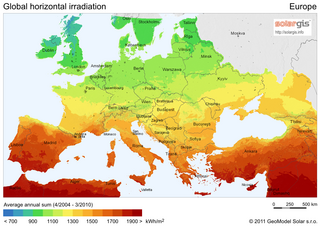
Photovoltaics (PV) is the conversion of light into electricity using semiconducting materials that exhibit the photovoltaic effect, a phenomenon studied in physics, photochemistry, and electrochemistry. The photovoltaic effect is commercially used for electricity generation and as photosensors.
Suntech Power Holdings Co., Ltd. is a Chinese producer of solar panels, with 2,000 MW (2,700,000 hp) of annual production capacity by the end of 2011. It is headquartered in Wuxi, Jiangsu. Shunfeng International Clean Energy Limited, a HKSE listed renewable energy investment and Independent Power Producer company, acquired Suntech in 2014 following Suntech's bankruptcy in 2013. With offices or production facilities in every major market, Suntech has delivered more than 13,000,000 solar panels to thousands of companies in more than 80 countries around the world. As the center for the company's global operations, Suntech headquarters, in Wuxi, China, features the world's largest building integrated solar facade.

Many countries and territories have installed significant solar power capacity into their electrical grids to supplement or provide an alternative to conventional energy sources. Solar power plants use one of two technologies:

Spain is one of the first countries to deploy large-scale solar photovoltaics, and is the world leader in concentrated solar power (CSP) production.

Solar power in Germany consists almost exclusively of photovoltaics (PV) and accounted for an estimated 8.2 percent of the country's gross-electricity generation in 2019. About 1.5 million photovoltaic systems were installed around the country in 2014, ranging from small rooftop systems, to medium commercial and large utility-scale solar parks. Germany's largest solar farms are located in Meuro, Neuhardenberg, and Templin with capacities over 100 MW.
Sharp Solar, a subsidiary of Sharp Electronics, is a solar energy products company owned by Sharp Corporation and based in Osaka, Japan.

Solar power is a growing source in the Portuguese energy mix. At the end of 2020, solar power installed capacity totalled 1.03 GW and represented 3.6% of total power generation in 2020.

Solar power consists of photovoltaics (PV) and solar thermal energy in the European Union.
China is the largest market in the world for both photovoltaics and solar thermal energy. China's photovoltaic industry began by making panels for satellites, and transitioned to the manufacture of domestic panels in the late 1990s. After substantial government incentives were introduced in 2011, China's solar power market grew dramatically: the country became the world's leading installer of photovoltaics in 2013. China surpassed Germany as the world's largest producer of photovoltaic energy in 2015, and became the first country to have over 100 GW of total installed photovoltaic capacity in 2017.

Solar power in Japan has been expanding since the late 1990s. The country is a major manufacturer and exporter of photovoltaics (PV) and a large installer of domestic PV systems, with most of them grid connected. Japan has a solar irradiance of about 4.3 to 4.8 kWh/(m2·day).

Worldwide growth of photovoltaics has been close to exponential between 1992 and 2018. During this period of time, photovoltaics (PV), also known as solar PV, evolved from a niche market of small-scale applications to a mainstream electricity source.

Solar power in Arizona has the potential to, according to then-Governor Janet Napolitano, make Arizona "the Persian Gulf of solar energy". In 2012, Arizona had 1,106 MW of photovoltaic (PV) solar power systems, and 6 MW of concentrated solar power (CSP), bringing the total to over 1,112 megawatts (MW) of solar power. As an example, the Solana Generating Station, a 280 MW parabolic trough solar plant, when commissioned in 2013, was the largest parabolic trough plant in the world and the first U.S. solar plant with molten salt thermal energy storage.

Italy's solar power generation capacity is one of the largest in the world, with its 22.56 GW putting it sixth, just ahead of Australia. In 2019, Italy set a national goal of reaching 50 GW by 2030. In 2022, Italy is anticipating more than 3 GW of new capacity, which will be the largest addition to solar generation since 2012.

Solar power in France including overseas territories reached an installed capacity figure of 11.2 GW by the end of 2020.

Solar power in Florida has been increasing, as the cost of solar power systems using photovoltaics (PV) has decreased in recent years. Florida has low electricity costs compared with other states, which makes individual solar investment less attractive. Florida ranks ninth nationally in solar resource strength according to the National Renewable Energy Laboratory and tenth in solar generation by the Solar Energy Industries Association.

Solar power in Massachusetts has been increasing rapidly, due to Section 1603 grants for installations that began before December 31, 2011, and the sale of SRECs for $0.30/kWh, which allows payback for the system within 5 or 6 years, and generates income for the life of the system. For systems installed after December 31, 2011, and before December 31, 2016, the 30% tax grant becomes a 30% tax credit. There has been an appeal to the Congress to extend the 1603 program, the grant program, for an additional year.

The total installed solar power in Brazil was estimated at about 21 GW at October 2022, generating approximately 2.48% of the country's electricity demand, up from 0.7% in 2018. In 2021, Brazil was the 14th country in the world in terms of installed solar power, and the 11th largest producer of solar energy in the world.
Under its commitment to the EU renewable energy directive of 2009, France has a target of producing 23% of its total energy needs from renewable energy by 2020. This figure breaks down to renewable energy providing 33% of energy used in the heating and cooling sector, 27% of the electricity sector and 10.5% in the transport sector. By the end of 2014, 14.3% of France's total energy requirements came from renewable energy, a rise from 9.6% in 2005.
The history of photovoltaic growth includes previous forecast and annual deployment figures by country.













